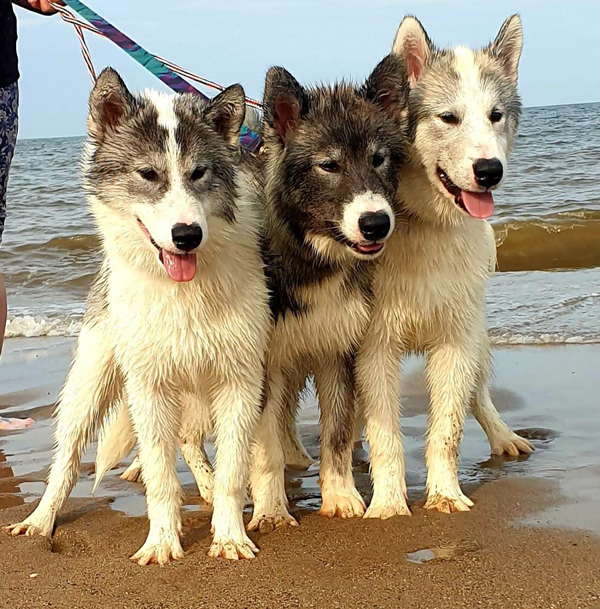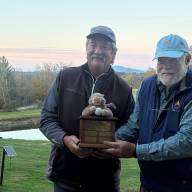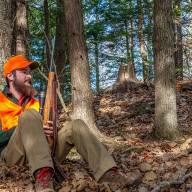A two-year-old rare Canadian Eskimo Dog named Igloo was named best in breed at a November Canadian Kennel Club competition in Calgary.
Igloo lives with Ernesto and Gretchen Rodriguez in Waitsfield. They got him when he was six months old, sourcing him from a breeder in Britian.
Eskimo Dogs are very rare, with only about 300 alive today. Their population was decimated in the 1950s and 1960 when they were shot en masse by Canadian Royal Mounties as part of resettling Inuit first nation people to the northwest of that country.
Having read about the breed and its poignant and tragic history, Rodriguez was intrigued by the possibility of finding such a dog.
INUIT PEOPLE
“At one point they were the lifeline of the Inuit people in the Canadian Arctic. I was fascinated by efforts underway to revive the breed,” he explained.
His understanding of why the dogs were shot is that the Royal Canadian Mounted Police wanted to move the Inuit quickly into settlement and when the dogs became an issue, they were shot.
Recent news reports from Reuters and Canadian Broadcast Company confirm that history and document how the Canadian government ultimately and belatedly apologized and issued $45 million in compensation. Those news reports are from November 2024.
“The primary factor in the dog’s decline was the forced relocation and mass slaughter. The Canadian government apologized and donated millions of dollars to preserve and restore the breed. It’s a Canadian symbol and a true breed that is pre-Columbian and not mixed with European breeds,” Rodriguez said.
MULTIPLE AWARDS
The dog is recognized in Europe and Britian, and they found Igloo from a British breeder who brought him from the UK to Canada. The Rodriguez family met her on the U.S. side of the St. Lawrence River. He was six months old at the time. The breeder had shown Igloo herself and he’d won multiple awards.
 “He represents the breed really well. Confirmation shows are not beauty pageants. They are for dogs that best represent the breeds,” he explained. The Rodriguezs traveled to Calgary for the competition this fall and had handlers show him. At that show he won best in breed. Show dogs like Igloo accumulate points in competitions and Igloo is now three points away from winning the Canadian championship.
“He represents the breed really well. Confirmation shows are not beauty pageants. They are for dogs that best represent the breeds,” he explained. The Rodriguezs traveled to Calgary for the competition this fall and had handlers show him. At that show he won best in breed. Show dogs like Igloo accumulate points in competitions and Igloo is now three points away from winning the Canadian championship.
“If I end up with a good dog, with good genes, we can make a contribution to the breed coming back. I’m not interested in becoming a breeder and not interested in making money from him,” he noted.
HAULING AND HUNTING
Before the forced resettlement of the Inuit people, the dogs were used for hauling freight and to help with hunting caribou, elk, polar bears and seals. The dogs were adept at locating seals’ air holes where they surfaced for breathing and were good at driving polar bears to Inuit hunters. Additionally, the dogs had the ability to sense when and where the ice was too thin for travel and they would instinctively circumvent weak areas. Unlike some sled pulling dogs, these dogs were work dogs versus racing dogs.
At one point, the Canadian Eskimo Dogs had American Kennel Club recognition and membership but it lapsed and almost two months ago Rodriguez initiated the process of getting registration reinstated for the breed. Canadian Eskimo dogs have already been accepted into the Foundation Stock Service program, he said.
Igloo is about 65 pounds and will get bigger and heavier as he grows. The dogs tend to top out at around 85 pounds, Rodriguez said. The dogs are bigger than Malamutes and they take Igloo bike skijoring during the summer and this winter he is learning to pull a sled.
DOESN’T BARK
“He doesn’t have any protective instincts. He doesn’t bark. If you come to the house, he’ll wag his tail and come to you. These dogs were not bred to be guardian dogs and if strangers came to an Inuit village, invariably they were family members or friends, and what’s the point of barking at family or friends?” Rodriguez asked.
Igloo lives in High Bridge Hill, off Brook Road in Waitsfield and goes on long walks up Brook Road and onto the Common Road. He’s still a puppy in many ways and he’s being trained on a GPS collar because he can be impulsive when he’s off leash.
“Hopefully he won’t be so impulsive when he matures,” he added.
Rodriguez has been in Vermont for 20 years. He grew up in Nicaragua with a Cuban father and Nicaraguan mother. He received a Fulbright scholarship to attend St. Michael’s College which he did. That was during the height of the civil war between the Sandinistas and Contras in Nicaragua and he was able to stay in the states because of the danger of political persecution.
He is a software consultant and pre-pandemic he traveled weekly for work. Before seeking out a Canadian Eskimo dog, he and his wife had (and still have) a 13-year-old Spanish water dog, a cousin to the Portuguese water dog. That dog, Paco, was not enamored of Igloo when the puppy came to live with them. After an initial period of baring his teeth at Igloo, Paco has come around.













